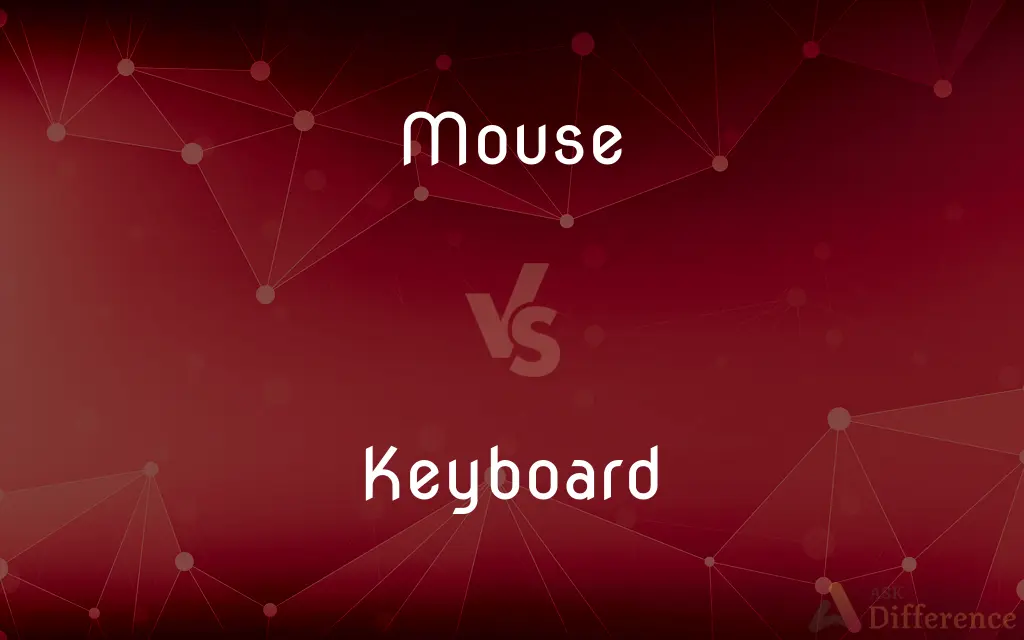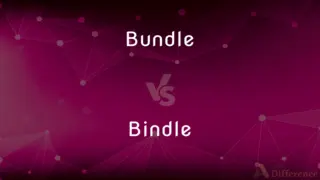Mouse vs. Keyboard — What's the Difference?
Edited by Tayyaba Rehman — By Maham Liaqat — Updated on March 9, 2024
A mouse is a pointing device used for navigating and interacting with a computer interface, while a keyboard is an input device used for typing text and executing commands.

Difference Between Mouse and Keyboard
Table of Contents
ADVERTISEMENT
Key Differences
The mouse and keyboard serve as fundamental input devices for computers, but they fulfill distinct roles. A mouse is primarily designed for pointing, clicking, and dragging objects within a graphical user interface, offering a more intuitive way to navigate digital environments. The keyboard, on the other hand, is essential for entering text, numbers, and executing predefined commands, providing a more efficient method for data entry and command execution.
While the mouse excels in tasks that require precision in selection and manipulation of on-screen items, such as graphic design or gaming, the keyboard offers speed and versatility for typing and programming tasks. Keyboard shortcuts can significantly enhance productivity by allowing quick access to functions without navigating through menus.
The ergonomics and user preference play significant roles in the utilization of these devices. Some users may prefer a mouse for its ease of navigation and less strain on the fingers when performing tasks that do not require extensive typing. Conversely, others might find keyboards more comfortable for prolonged use, especially when equipped with ergonomic features to reduce strain.
In terms of technological evolution, both devices have seen significant advancements. Mice have evolved from mechanical balls to optical and laser tracking, offering higher precision and smoother movement. Keyboards have transitioned from mechanical switches to membrane and capacitive technology, catering to different typing preferences and needs.
Despite their differences, the mouse and keyboard often work in tandem to provide a comprehensive input mechanism for computer users. While alternative input methods like touchscreens and voice commands have gained popularity, the mouse and keyboard remain indispensable tools for tasks requiring precision and efficiency.
ADVERTISEMENT
Comparison Chart
Primary Function
Navigating and interacting with a computer interface
Typing text and executing commands
Key Features
Pointing, clicking, dragging
Entering text, numbers, and shortcuts
Ideal for
Precision tasks like graphic design, gaming
Typing, programming, data entry
Ergonomics
May reduce finger strain in non-typing tasks
Can be equipped with ergonomic features for comfort
Technological Evolution
From mechanical to optical/laser tracking
From mechanical switches to membrane/capacitive
User Preference
Favored for intuitive navigation
Preferred for efficiency in typing and command execution
Compare with Definitions
Mouse
A hand-held pointing device for computers, used to navigate and interact with digital interfaces.
She used the mouse to click on the application icon.
Keyboard
An input device with keys for typing text, numbers, and executing commands.
She typed the report quickly using the keyboard.
Mouse
Enables precise control over cursor movement on screen.
The designer used a mouse to meticulously edit the digital image.
Keyboard
Key for command-based and text-heavy applications.
Writing code is more efficient when using a keyboard with custom shortcuts.
Mouse
Often preferred for tasks requiring spatial manipulation.
He prefers using a mouse for editing videos because of the precision it offers.
Keyboard
Includes various types from mechanical to ergonomic designs.
The mechanical keyboard offers a satisfying click sound with each keystroke.
Mouse
Has evolved from ball-based to optical and laser sensors for improved accuracy.
His gaming mouse features high-precision laser tracking for better performance.
Keyboard
Favored for extensive typing and data entry tasks.
Authors prefer keyboards for writing due to their speed and efficiency.
Mouse
Essential for graphical interfaces, enhancing user interaction.
Navigating the website was easier with the mouse due to its intuitive design.
Keyboard
Provides a tactile method for entering data and shortcuts.
Programmers use keyboard shortcuts to streamline their coding process.
Mouse
A mouse, plural mice, is a small rodent. Characteristically, mice are known to have a pointed snout, small rounded ears, a body-length scaly tail, and a high breeding rate.
Keyboard
Holder consisting of an arrangement of hooks on which keys or locks can be hung
Mouse
A small rodent that typically has a pointed snout, relatively large ears and eyes, and a long tail.
Keyboard
A panel of buttons used for typing and performing other functions on a computer or typewriter.
Mouse
A small handheld device which is moved across a mat or flat surface to move the cursor on a computer screen
The right mouse button
Copy the file with a click of the mouse
Keyboard
A row of levers that are depressed with the fingers to produce or modulate the sound of an instrument, such as a piano or organ.
Mouse
A lump or bruise on or near the eye
She touched the mouse under her eye
Keyboard
Any of various instruments, played by means of a musical keyboard, often connected to a synthesizer or amplifier.
Mouse
(of a cat or owl) hunt for or catch mice
Female cats are usually much better at mousing than males
Keyboard
To set (copy) by means of a keyed typesetting machine
Keyboard a manuscript.
Mouse
Use a mouse to move or position a cursor on a computer screen
Simply mouse over any item on the list
Keyboard
To enter (text or data) into a computer by means of a keyboard.
Mouse
Any of numerous small rodents of the families Muridae and Cricetidae, such as the house mouse, characteristically having a pointed snout, small rounded ears, and a long naked or almost hairless tail.
Keyboard
(Music) To play (a composition) on a piano or keyboard.
Mouse
Any of various similar or related animals, such as the jumping mouse, the vole, or the jerboa.
Keyboard
A set of keys used to operate a typewriter, computer etc.
Mouse
A cowardly or timid person.
Keyboard
(music) A component of many instruments including the piano, organ, and harpsichord consisting of usually black and white keys that cause different tones to be produced when struck.
Mouse
(Informal) A discolored swelling under the eye caused by a blow; a black eye.
Keyboard
(music) A device with keys of a musical keyboard, used to control electronic sound-producing devices which may be built into or separate from the keyboard device.
Mouse
Pl. mice or mous·es (mousĭz) Computers A handheld, button-activated input device that when rolled along a flat surface directs an indicator to move correspondingly about a computer screen, allowing the operator to move the indicator freely, as to select operations or manipulate text or graphics.
Keyboard
(intransitive) To type on a computer keyboard.
Keyboarding is the part of this job I hate the most.
Mouse
To hunt mice.
Keyboard
The whole arrangement, or one range, of the keys{3} of an organ, piano, typewriter, etc.; that part of a device containing the keys{3} used to operate it.
Mouse
To search furtively for something; prowl.
Keyboard
Device consisting of a set of keys on a piano or organ or typewriter or typesetting machine or computer or the like
Mouse
Any small rodent of the genus Mus.
Mouse
(informal) A member of the many small rodent and marsupial species resembling such a rodent.
Mouse
A quiet or shy person.
Mouse
(computing) (plural mice or, rarely, mouses) An input device that is moved over a pad or other flat surface to produce a corresponding movement of a pointer on a graphical display.
Mouse
(computing) The cursor.
Mouse
(boxing) A facial hematoma or black eye.
Mouse
(nautical) A turn or lashing of spun yarn or small stuff, or a metallic clasp or fastening, uniting the point and shank of a hook to prevent its unhooking or straightening out.
Mouse
(obsolete) A familiar term of endearment.
Mouse
A match used in firing guns or blasting.
Mouse
(set theory) A small model of (a fragment of) Zermelo-Fraenkel set theory with desirable properties (depending on the context).
Mouse
(historical) A small cushion for a woman's hair.
Mouse
Part of a hind leg of beef, next to the round.
Mouse
(intransitive) To move cautiously or furtively, in the manner of a mouse (the rodent) (frequently used in the phrasal verb to mouse around).
Mouse
(intransitive) To hunt or catch mice (the rodents), usually of cats. 12
Mouse
To close the mouth of a hook by a careful binding of marline or wire.
Mouse
To navigate by means of a computer mouse.
Mouse
To tear, as a cat devours a mouse.
Mouse
Any one of numerous species of small rodents belonging to the genus Mus and various related genera of the family Muridæ. The common house mouse (Mus musculus) is found in nearly all countries. The American white-footed mouse, or deer mouse (Peromyscus leucopus, formerly Hesperomys leucopus) sometimes lives in houses. See Dormouse, Meadow mouse, under Meadow, and Harvest mouse, under Harvest.
Mouse
A knob made on a rope with spun yarn or parceling to prevent a running eye from slipping.
Mouse
A familiar term of endearment.
Mouse
A dark-colored swelling caused by a blow.
Mouse
A match used in firing guns or blasting.
Mouse
To watch for and catch mice.
Mouse
To watch for or pursue anything in a sly manner; to pry about, on the lookout for something.
Mouse
To tear, as a cat devours a mouse.
Mouse
Any of numerous small rodents typically resembling diminutive rats having pointed snouts and small ears on elongated bodies with slender usually hairless tails
Mouse
A hand-operated electronic device that controls the coordinates of a cursor on your computer screen as you move it around on a pad; on the bottom of the mouse is a ball that rolls on the surface of the pad;
A mouse takes much more room than a trackball
Mouse
To go stealthily or furtively;
..stead of sneaking around spying on the neighbor's house
Mouse
Manipulate the mouse of a computer
Common Curiosities
Can you use a computer with just a mouse or keyboard?
While possible, using both devices together enhances efficiency and functionality.
Which is better for gaming, mouse or keyboard?
Both are essential; the mouse for aiming and camera control, and the keyboard for movement and shortcuts.
Can keyboards be customized?
Yes, keyboards can be customized with different keys, layouts, and programmable shortcuts.
How do you clean a mouse or keyboard?
Both can be cleaned with compressed air, isopropyl alcohol, and soft cloths, but always follow manufacturer guidelines.
Are there ergonomic options for both mouse and keyboard?
Yes, ergonomic designs are available for both to reduce strain and improve comfort.
How do keyboard shortcuts enhance productivity?
Shortcuts allow quick access to functions without navigating through menus, saving time.
Is a wireless mouse or keyboard better than wired?
It depends on user preference; wireless offers freedom of movement, while wired provides reliability without battery concerns.
What advancements have been made in mouse technology?
Advances include higher DPI sensitivity, customizable buttons, and ergonomic designs.
Can a mouse and keyboard be used with mobile devices?
Yes, many can connect via Bluetooth or USB with compatible mobile devices.
Are there alternatives to traditional mouse and keyboard setups?
Yes, alternatives like touchscreens, styluses, and voice recognition offer different input methods.
Share Your Discovery

Previous Comparison
Thiol vs. Thiolate
Next Comparison
Bundle vs. BindleAuthor Spotlight
Written by
Maham LiaqatEdited by
Tayyaba RehmanTayyaba Rehman is a distinguished writer, currently serving as a primary contributor to askdifference.com. As a researcher in semantics and etymology, Tayyaba's passion for the complexity of languages and their distinctions has found a perfect home on the platform. Tayyaba delves into the intricacies of language, distinguishing between commonly confused words and phrases, thereby providing clarity for readers worldwide.
















































